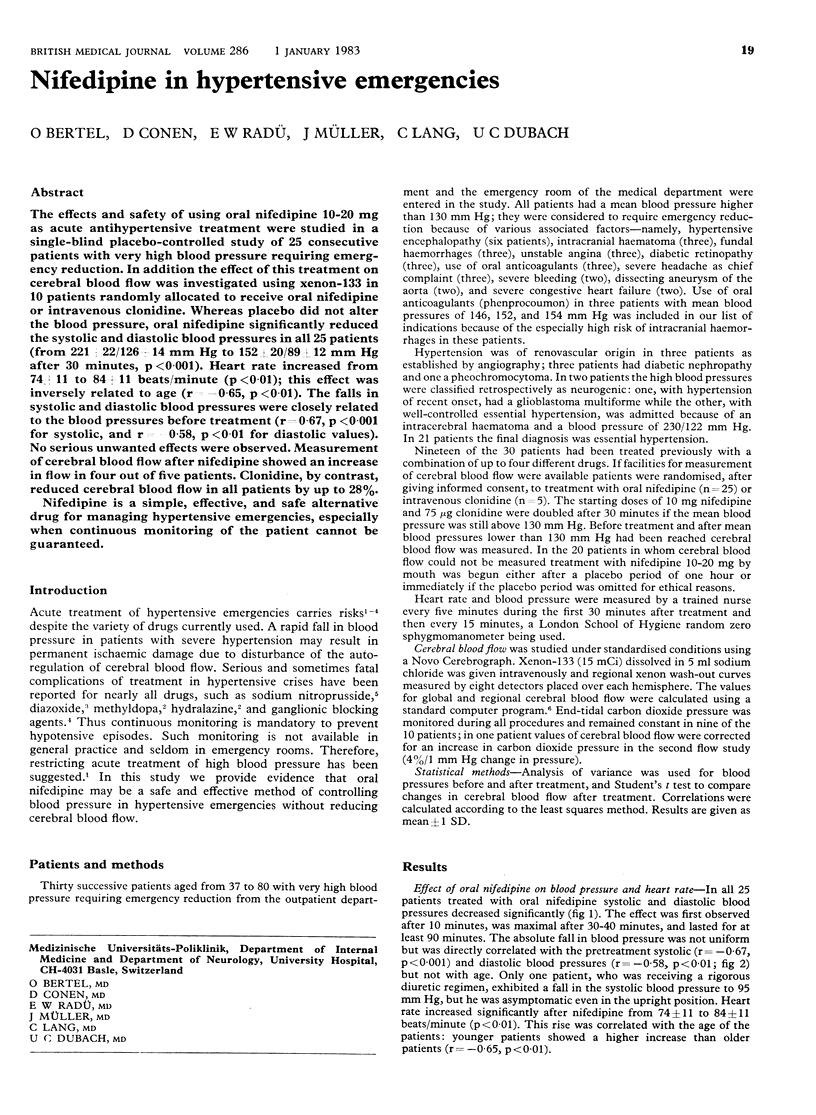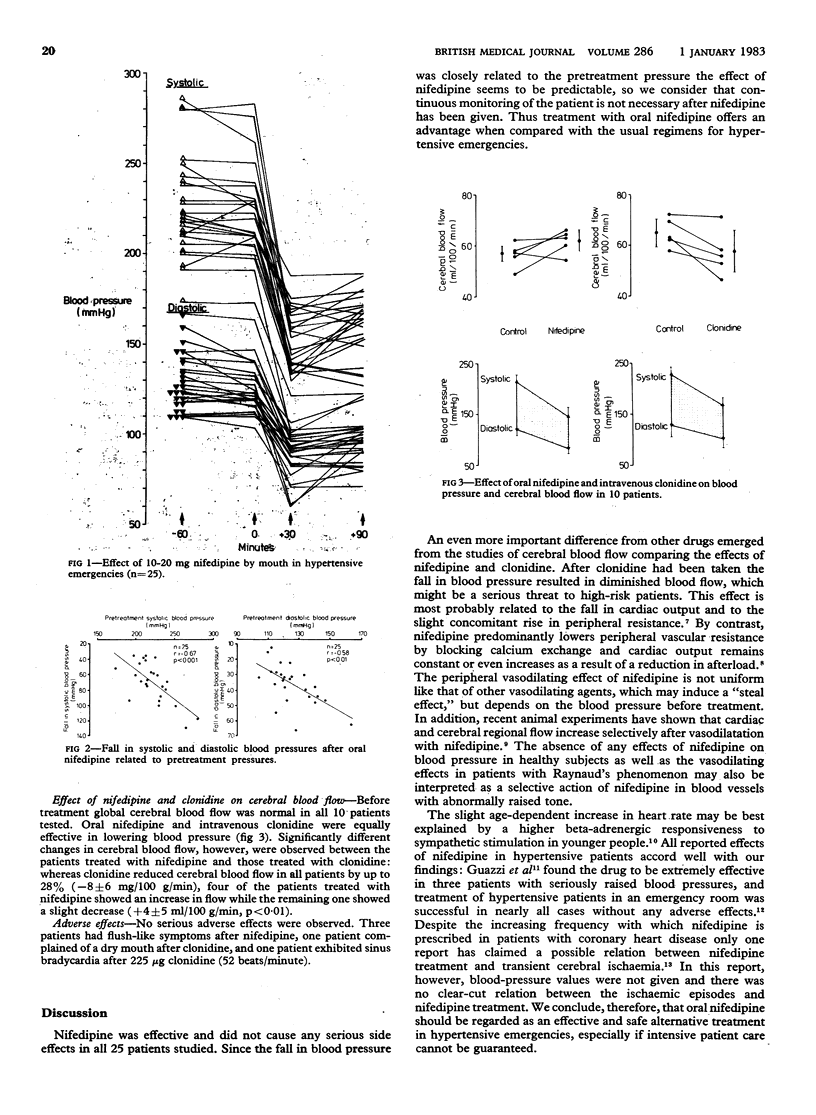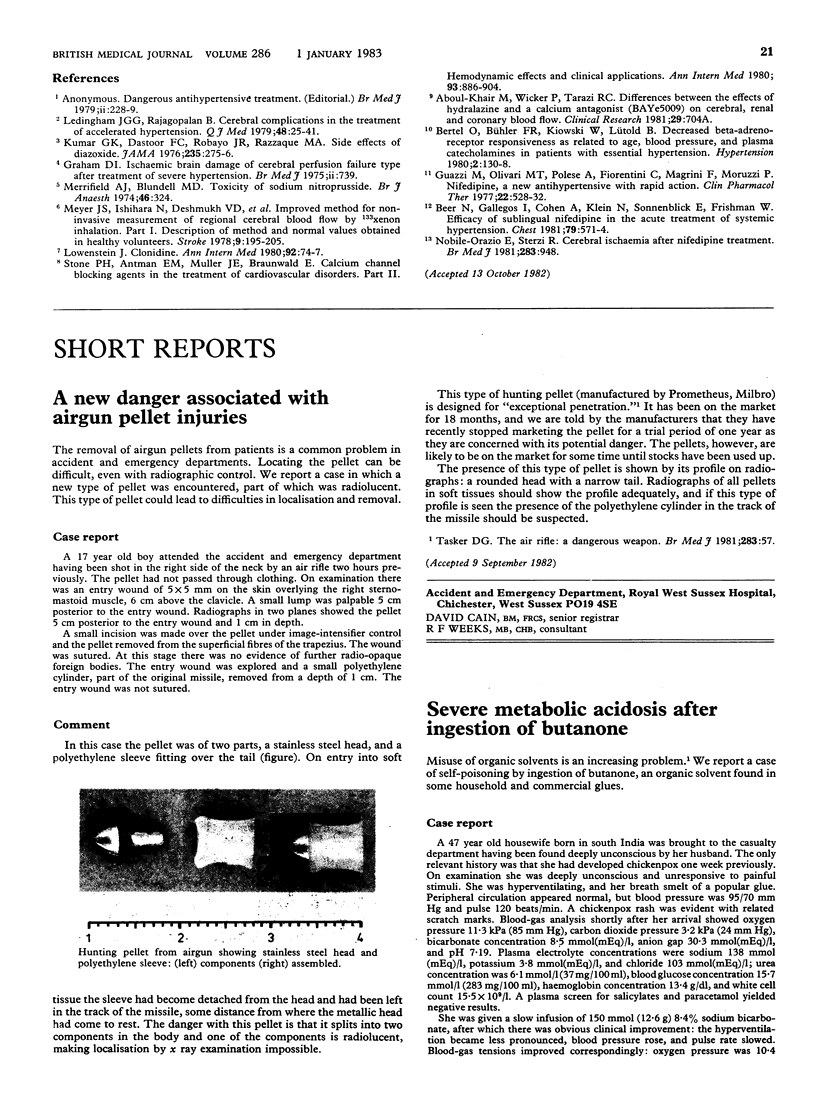Abstract
The effects and safety of using oral nifedipine 10-20 mg as acute antihypertensive treatment were studied in a single-blind placebo-controlled study of 25 consecutive patients with very high blood pressure requiring emergency reduction. In addition the effect of this treatment on cerebral blood flow was investigated using xenon-133 in 10 patients randomly allocated to receive oral nifedipine or intravenous clonidine. Whereas placebo did not alter the blood pressure, oral nifedipine significantly reduced the systolic and diastolic blood pressures in all 25 patients (from 221 +/- 22/126 +/- 14 mm Hg to 152 +/- 20/89 +/- 12 mm Hg after 30 minutes, p less than 0.001). Heart rate increased from 74 +/- 11 to 84 +/- 11 beats/minute (p less than 0.01); this effect was inversely related to age (r = -0.65, p less than 0.01). The falls in systolic and diastolic blood pressures were closely related to the blood pressures before treatment ) r = 0.67, p less than 0.001 for systolic, and r = -0.58, p less than 0.01 for diastolic values). No serious unwanted effects were observed. Measurement of cerebral blood flow after nifedipine showed an increase in flow in four out of five patients. Clonidine, by contrast, reduced cerebral blood flow in all patients by up to 28%. Nifedipine is a simple, effective, and safe alternative drug for managing hypertensive emergencies, especially when continuous monitoring of the patient cannot be guaranteed.
Full text
PDF


Images in this article
Selected References
These references are in PubMed. This may not be the complete list of references from this article.
- Beer N., Gallegos I., Cohen A., Klein N., Sonnenblick E., Frishman W. Efficacy of sublingual nifedipine in the acute treatment of systemic hypertension. Chest. 1981 May;79(5):571–574. doi: 10.1378/chest.79.5.571. [DOI] [PubMed] [Google Scholar]
- Bertel O., Bühler F. R., Kiowski W., Lütold B. E. Decreased Beta-adrenoreceptor responsiveness as related to age, blood pressure, and plasma catecholamines in patients with essential hypertension. Hypertension. 1980 Mar-Apr;2(2):130–138. doi: 10.1161/01.hyp.2.2.130. [DOI] [PubMed] [Google Scholar]
- Graham D. I. Ischaemic brain damage of cerebral perfusion failure type after treatment of severe hypertension. Br Med J. 1975 Dec 27;4(5999):739–739. doi: 10.1136/bmj.4.5999.739. [DOI] [PMC free article] [PubMed] [Google Scholar]
- Guazzi M., Olivari M. T., Polese A., Fiorentini C., Magrini F., Moruzzi P. Nifedipine, a new antihypertensive with rapid action. Clin Pharmacol Ther. 1977 Nov;22(5 Pt 1):528–532. doi: 10.1002/cpt1977225part1528. [DOI] [PubMed] [Google Scholar]
- Kumar G. K., Dastoor F. C., Robayo J. R., Razzaque M. A. Side effects of diazoxide. JAMA. 1976 Jan 19;235(3):275–276. [PubMed] [Google Scholar]
- Ledingham J. G., Rajagopalan B. Cerebral complications in the treatment of accelerated hypertension. Q J Med. 1979 Jan;48(189):25–41. [PubMed] [Google Scholar]
- Lowenstein J. Drugs five years later: clonidine. Ann Intern Med. 1980 Jan;92(1):74–77. doi: 10.7326/0003-4819-92-1-74. [DOI] [PubMed] [Google Scholar]
- Merrifield A. J., Blundell M. D. Letter: Toxicity of sodium nitroprusside. Br J Anaesth. 1974 Apr;46(4):324–324. [PubMed] [Google Scholar]
- Meyer J. S., Ishihara N., Deshmukh V. D., Naritomi H., Sakai F., Hsu M. C., Pollack P. Improved method for noninvasive measurement of regional cerebral blood flow by 133Xenon inhalation. Part I: description of method and normal values obtained in healthy volunteers. Stroke. 1978 May-Jun;9(3):195–205. doi: 10.1161/01.str.9.3.195. [DOI] [PubMed] [Google Scholar]
- Nobile-Orazio E., Sterzi R. Cerebral ischaemia after nifedipine treatment. Br Med J (Clin Res Ed) 1981 Oct 10;283(6297):948–948. doi: 10.1136/bmj.283.6297.948. [DOI] [PMC free article] [PubMed] [Google Scholar]
- Stone P. H., Antman E. M., Muller J. E., Braunwald E. Calcium channel blocking agents in the treatment of cardiovascular disorders. Part II: Hemodynamic effects and clinical applications. Ann Intern Med. 1980 Dec;93(6):886–904. doi: 10.7326/0003-4819-93-6-886. [DOI] [PubMed] [Google Scholar]



